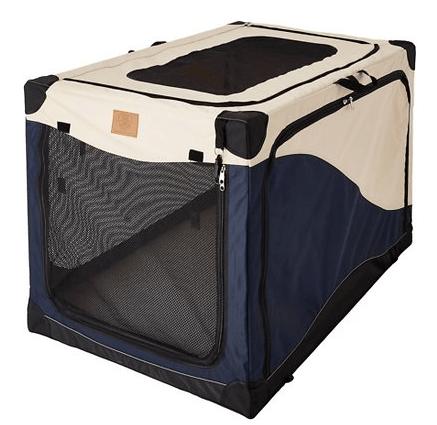How To Crate Train A Puppy (Plus 5 Excellent Crate Options)

Here’s some information on how to crate train a puppy. Remember to start this process early, so your puppy grows to love their crate!
Introduction
Bringing a new puppy home is one of the most exciting things you can do as a pet parent! You’ll want to spend all day, every day playing with them, and for the first few days, this might be all you do.
But that lifestyle won’t last forever. Eventually, you’ll need to leave your puppy at home alone, and this means that you may need them to be able to stay in their dog crate.
Puppies aren’t born with an understanding that their crate is a safe place for them, however, and going inside can be very scary.
Why Crate Train Your Puppy?
Dogs have a natural instinct to be den-driven animals. This means that having a cozy place to curl up and rest will make them very happy and comfortable.
Getting your puppy comfortable in their crate gives them a place where they can find comfort and solitude, and it also gives you the peace of mind that your puppy and your home are secure while you’re out.
Another benefit of crate training your puppy is that it is inevitable that your pet will need to be transported to the vet, the park, or somewhere else at some point. By crate training your dog, you ensure these trips won’t be as scary for your puppy!
Now that you know why you should crate train, let’s learn when and how!
When Should You Start Crate Training A Puppy?
It’s important to start crate training your puppy as soon as possible! While puppies under six months old should not be kept in a crate for more than three hours, they can still become familiar with the crate from a very early age.
The sooner your puppy is comfortable with the crate being around, the easier it will be to fully crate train them.
Basic Crate Training Process
Here’s a basic breakdown of how to crate train your puppy. Remember that every step needs the proper amount of time to ensure your puppy understands. Never be afraid to take more time on any of these steps!
1: Introduce The Crate
Bring a crate into your puppy’s life casually. Open all possible doors on it, and simply let it be in the room. Don’t address it; just let it sit there. Your curious puppy may explore it. They may even lay down inside!
Once they are no longer curious about it, move on to the next step!
2: Put Some Fun Things Inside
Putting blankets, toys, and even treats inside the crate can entice your puppy to explore and also to associate the crate with good things. Do this until they are less cautious about going inside.
3: Meal Time!
Next, try feeding your puppy in the crate. Put a meal inside, and leave the doors open. Direct your puppy to their meal, and see how they react.
Start with the meal at the front of the crate and move it towards the back as they get more comfortable.
4: Close The Door
Once your dog has no problem going to the back of their crate to eat, try shutting the door while they eat. As soon as they are finished eating, open the door.
Start waiting a few minutes before opening the door as time goes on. If they whine, let them out sooner next time, but never open the door immediately when they whine, or they may build this bad habit.
5: Extended Playtime
If your puppy is handling everything through step 4 without being stressed, you can now leave them in there for a longer period of time.
Lead your puppy into the crate, and then close it. Leave them in for a while. Hang nearby for a few minutes, and then leave the room for a little bit. Once you come back, don’t open the crate right away. Read nearby for a few minutes before opening the crate.
Keep extending this period of time until your puppy is comfortable in the crate for more than one or even two hours!
6: Leave The Home!
Now that your puppy is used to staying in the crate, you can try to leave home for a bit.
The most important thing is to not act like anything special is going on - just leave! Act very low key as you leave home and as you return. This will help your dog understand that this is a normal activity. Small praise is okay, but don’t make it a huge deal.
7: Overnighting
You can actually try to crate your puppy overnight after step 5, but I think it is better to wait a bit longer. Remember that overnighting is possible, but you will need to let your puppy out at least one time during the night to use the bathroom. Keep the crate near you so you know when the puppy needs to go out.
Sample Crate Training Schedule
Here’s a simple breakdown of what a crate training schedule for your puppy might look like.
There you have it! You can lengthen or shorten each section depending on your pet’s particular reaction and needs.
Crate Size
You might be wondering what size dog crate to use for your puppy. Figuring out how big should a dog crate be is one of the hardest parts of training!
Choose a crate that’s big enough for your dog to turn around and lay down. It shouldn’t be too big. If it is, they will be able to defecate at one end and lay in the other, which isn’t good. Block off any extra space, or rent a smaller crate until your pet is fully grown.
Check this video out for more info:
Night Time Crating
Crate training a puppy at night can be difficult because puppies are used to you being around them, especially at night. You might even encounter puppies crying in crate at night.
There are a few reasons this may be happening:
- Separation anxiety - consult a trainer or vet for help
- Need to go to the bathroom - expect to take puppies out 1-2 times during the night until they get older
- Too soon - they might need more time before they’re left alone in the crate at night
If you are still having trouble with your puppy crying at night after addressing these problems, consult a professional trainer for more personalized assistance.
5 Crate Options To Consider
The process of training a puppy is difficult enough without also having to choose out the perfect crate. Because I know how complicated this whole process can be, I’ve narrowed down some great crate choices for you.
This dog crate is a great option for new pet owners and their puppies because it has two doors that can open. This is helpful for training purposes, as some dogs don’t like being locked in. Opening both doors at first can make the training process easier!
This crate is ideal for outdoor fun, so it’s a good option if you expect to be traveling with your dog a lot or you want them to come along on many outdoor adventures. The crate allows for good circulation and a safe environment.
A top load plastic kennel like this one is great to train your puppy in because it can then be used to go to the vet or on vacation together. Getting your puppy used to this crate will prepare them for many future adventures!
Another double door crate, this is a good option for any puppies who are having a hard time being comfortable inside a traditional crate. Plus, this is very secure - it locks all along the bottom, so even the smartest puppies won’t escape!
Get Training!
Now that you’ve learned the basics of crate training and you’ve also learned about the best crates to get for your puppy, get to it!
The only way to find out if your puppy will take to loving or hating the crate is to give them a chance to try it out. Remember to take things slow and to be patient; forcing your puppy to go into their crate before they’re ready can cause a lifelong fear of crates. Avoid this by being gentle in your training.
Do you have any more tips on how to crate train a puppy successfully? Share with us in the comments!






